Delay is more than just an echo effect; it’s a dynamic process that can enhance the rhythm, depth, and texture of your sound.
As well as transform the spatial perception within a mix.
You must know all about delay effects and parameters to sculpt the ambiance of a track and give your music that unique edge.
Mastering delay can empower you to take your productions from good to unforgettable, creating emotional moments that resonate with listeners.
You will be introduced to the intricacies of delay and its application in music production.
In today’s article, we’ll be breaking down:
- What is delay in music? ✓
- Secrets of delay parameters ✓
- Mastering delay time ✓
- How to use delays creatively ✓
- Analog delay, digital delay & tape delay nuances ✓
- Innovations in delay units ✓
- Digital signal processing electronics
- Elevating tracks with delay ✓
- Crafting iconic beats with delay techniques ✓
- How to master your favorite delay plugin ✓
- Much more ✓
You’ll be able to apply delay to your music like a professional 一 enhancing your tracks with rich, intricate echoes and shaping soundscapes with precision.
Whether you’re fine-tuning a mix or crafting a new piece, the skills you’ll gain here will elevate your music production.
So, let’s dive in…
Table of Contents
What is Delay?
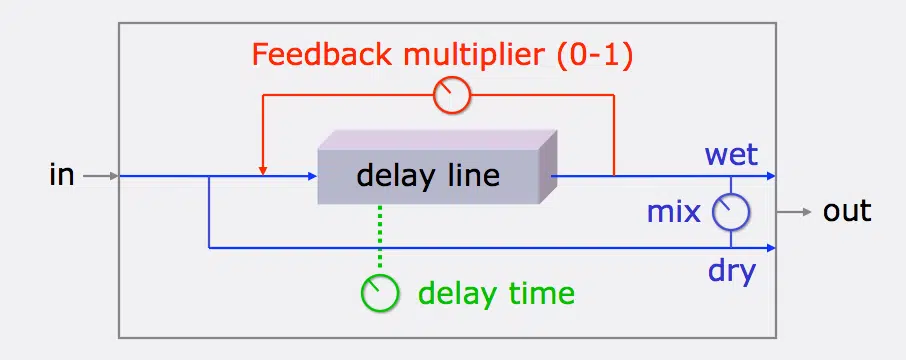
Delay is a replication of sound that occurs at a later time following the original signal.
Imagine striking a chord on a guitar and then hearing that same chord repeat itself moments later… That’s the delay effect at work.
This distinct echo effect can instantly captivate audiences.
This ranges from subtle repetition, which adds a sense of space to a mix, to pronounced echoes, which become a rhythmic and melodic part of the musical composition.
It’s not just an echo, though; it’s a creative tool that can add:
- Depth
- Movement
- An entirely new dimension to your sound
When you use delays creatively, it can be the difference between a flat, lifeless production and one that pulses with energy.
When it comes to any delayed effect, it’s essential to recognize its impact.
From thickening up vocals to creating complex rhythmic patterns, a delay unit or delay plug in can be your sonic Swiss Army knife.
It’s always ready to bring new textures into your music production flow.
Key Delay Parameters: Explained
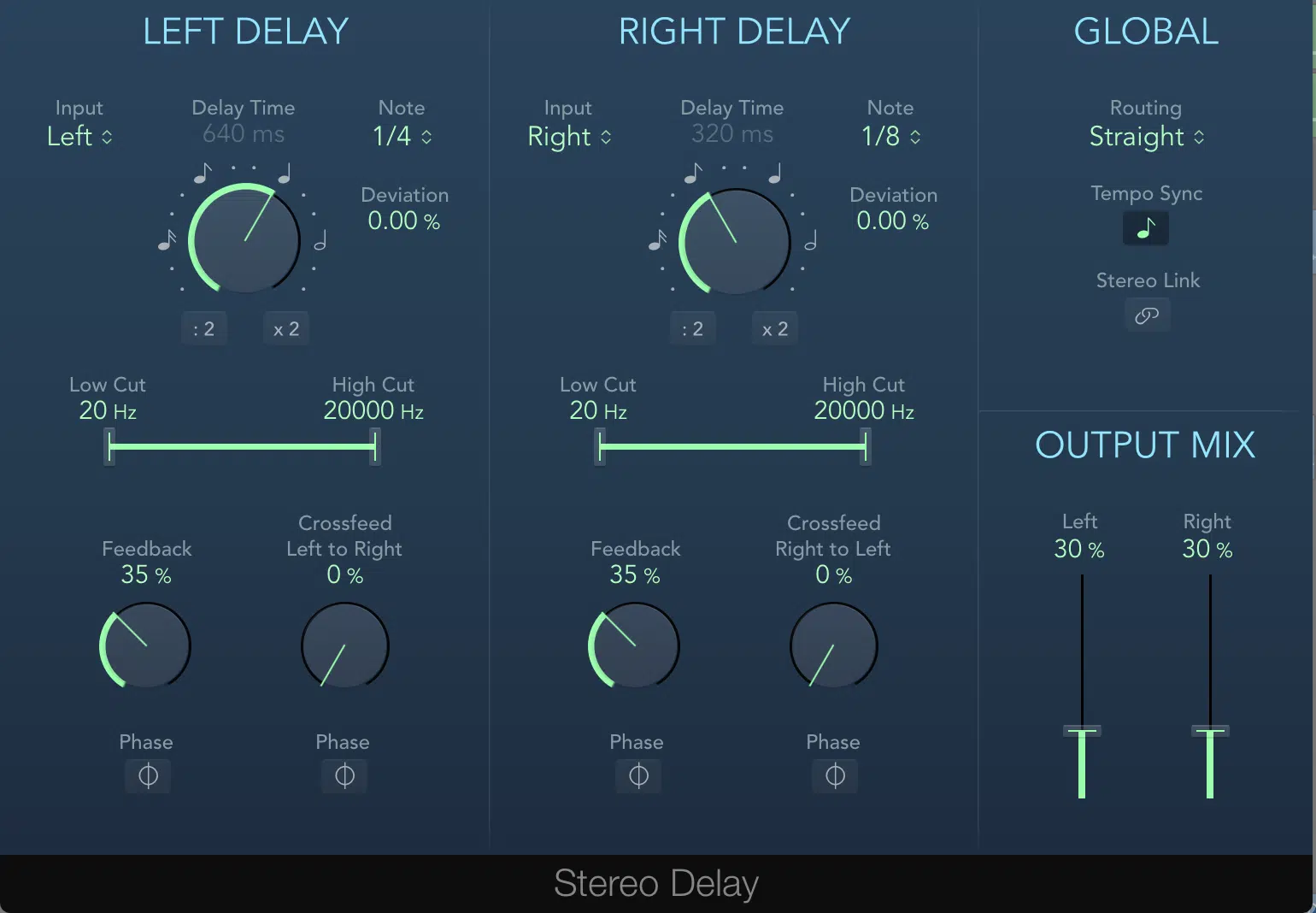
To master delay, it’s crucial to understand the parameters that mold it.
The key delay components include delay time, feedback, wet/dry mix, and modulation.
Delay time is the interval between the original signal and its echo, and it can be set to milliseconds or synced to the track’s tempo.
It often creates a rhythmic counterpart to the dry signal.
Feedback determines how many times the delayed signal will repeat.
Low feedback settings will create a few echos (suitable for a subtle audio effect), while higher settings create a continuous decay of repeats that adds lush delay tails.
The wet/dry mix is about balance.
The ‘dry’ signal is your original sound, untouched and pure, while the ‘wet’ signal is the effected sound, the one processed with delay.
Modulation in the context of delay can add a pitch-shifting aspect to the repeats, offering a richer, more complex sound.
Think of it like chorus effects, where the delayed signal gets a slight wobble 一 providing a sense of depth and movement.
If you’d to know everything about chorus effects, we’ve got you covered.
Understanding these parameters is essential, as they give you the creative control to shape the delayed signal (not the input signal) however you want.
Delay Time: The Backbone of the Effect
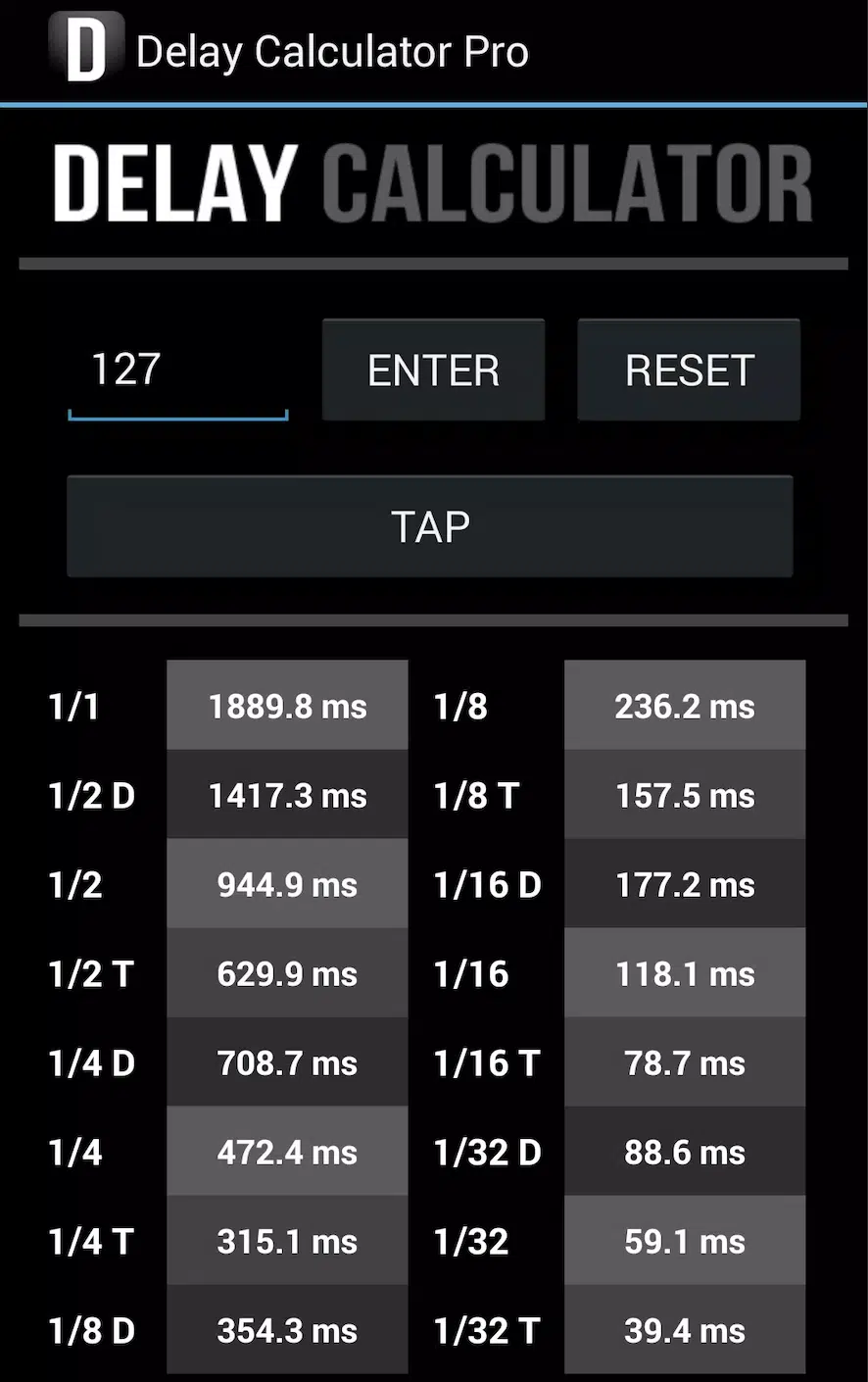
At the heart of the delay effect lies the delay time.
This crucial parameter determines the rhythm and spacing of the delayed signal, making it a pivotal factor in how the effect interacts with the original sound.
Delay time can be as:
- Short as a few milliseconds (for a doubling effect, delayed duplicates, or dual-delay effect that adds thickness to a sound).
- Long as several seconds (for dramatic, ambient trails that fill out a track).
For an aspiring music producer or audio engineers, manipulating delay time can be a rhythmic tool.
By syncing delay time with the track’s tempo, you can create echoes that dance in time with the beat 一 adding a groove that wasn’t there before.
When discussing delay in music, it’s essential to mention the term ‘tap tempo.’
The Tap Tempo feature allows you to manually set the delay time to match the tempo of your song.
Exploring the extremes of delay time can yield exciting results, too.
Very short delay times can cause phase cancellation and flanging effects, while extremely long delay times can turn your sounds into a cascading series of echoes.
Types of Delay Effects
Transitioning from the concept of delay time, let’s explore the various types of delay effects that have shaped the sound of countless hit records.
Each type of delay brings its own texture and can be chosen based on the specific vibe you’re aiming for in your production.
-
The Analog Delay Experience
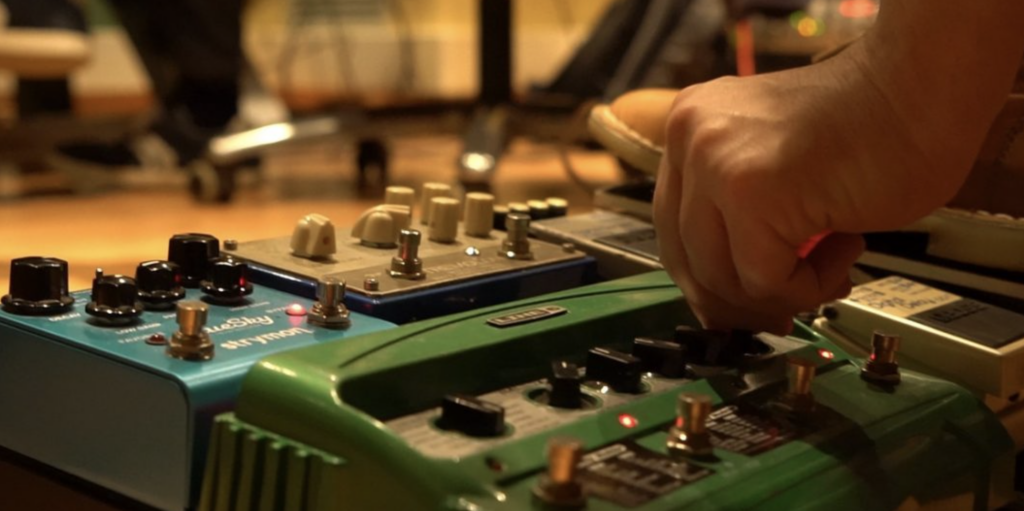
When you use delay, even digitally, you must know about analog delay.
Analog delay is characterized by its warm, often gritty sound, resulting from how analog circuits process the audio signal.
When the delay signal repeats, each echo degrades slightly, losing high-frequency content and becoming softer with each repetition.
This creates a musical decay that can feel more natural or organic compared to its digital counterpart.
Analog delay units, often using bucket-brigade devices (BBDs), have a distinct sound that can imbue tracks with a nostalgic vibe.
As these echoes repeat, they offer a sense of warmth that has become synonymous with vintage recordings.
Using analog delay, you can expect a gradual loss in fidelity with each echo, which can be pretty desirable for specific genres (like lo-fi).
The warm repeats can blend seamlessly with a mix 一 avoiding the sometimes sterile repetitions of digital units.
However, the analog delay effect is not without its limitations.
The nature of analog delay devices means shorter maximum delay times and potential for noise accumulation in the signal path.
The charm of analog delays, despite the technological advancements in digital delays, remains untarnished.
Even in the digital realm, many delay plugins are designed to emulate the nuances of analog delay units, striving to replicate the warmth and imperfections we all love.
-
The Precision of Digital Delay
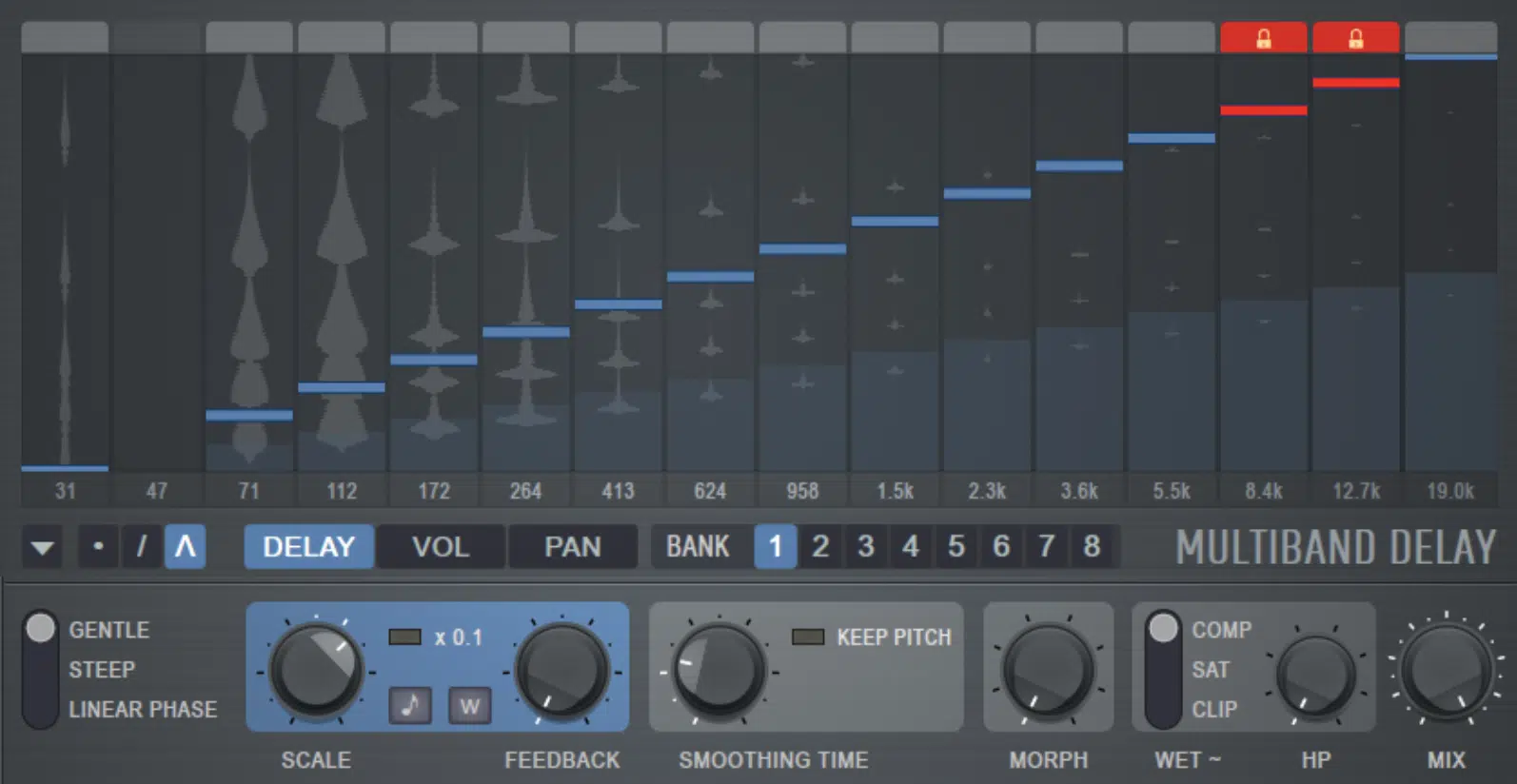
Digital delay offers clarity and precision that analog delay simply cannot.
With digital delay effects, the repeats can be crystal clear, and the delay time can be controlled with pinpoint accuracy.
This type of delay uses digital signal processing to create the delayed signal, resulting in a clean, exact echo that retains the sound quality of the original signal.
Digital delays offer extended delay times and complex algorithms that can simulate various environments.
This ranges from small rooms to vast spaces.
The sharp, clean repeats can be rhythmic elements in their own right, interacting with the beat in a way that defines the groove.
Producers and audio engineers often synchronize the delay time with the track’s BPM to create rhythmic patterns vital to the genre’s feel.
Digital delay units also offer advanced features such as:
- Reverse delays
- Multi-tap delays
- Modulated delays
These features can turn simple sounds into complex, evolving textures, making digital delay a powerful creative tool.
Additionally, digital delay can offer a more extensive range of control over the delay parameters 一 allowing for more nuanced adjustments to fit the mix perfectly.
Plus, digital delays have evolved to include emulation modes that replicate the sounds of classic analog and tape delay units, giving you the best of both worlds.
-
The Vintage Charm of Tape Delay
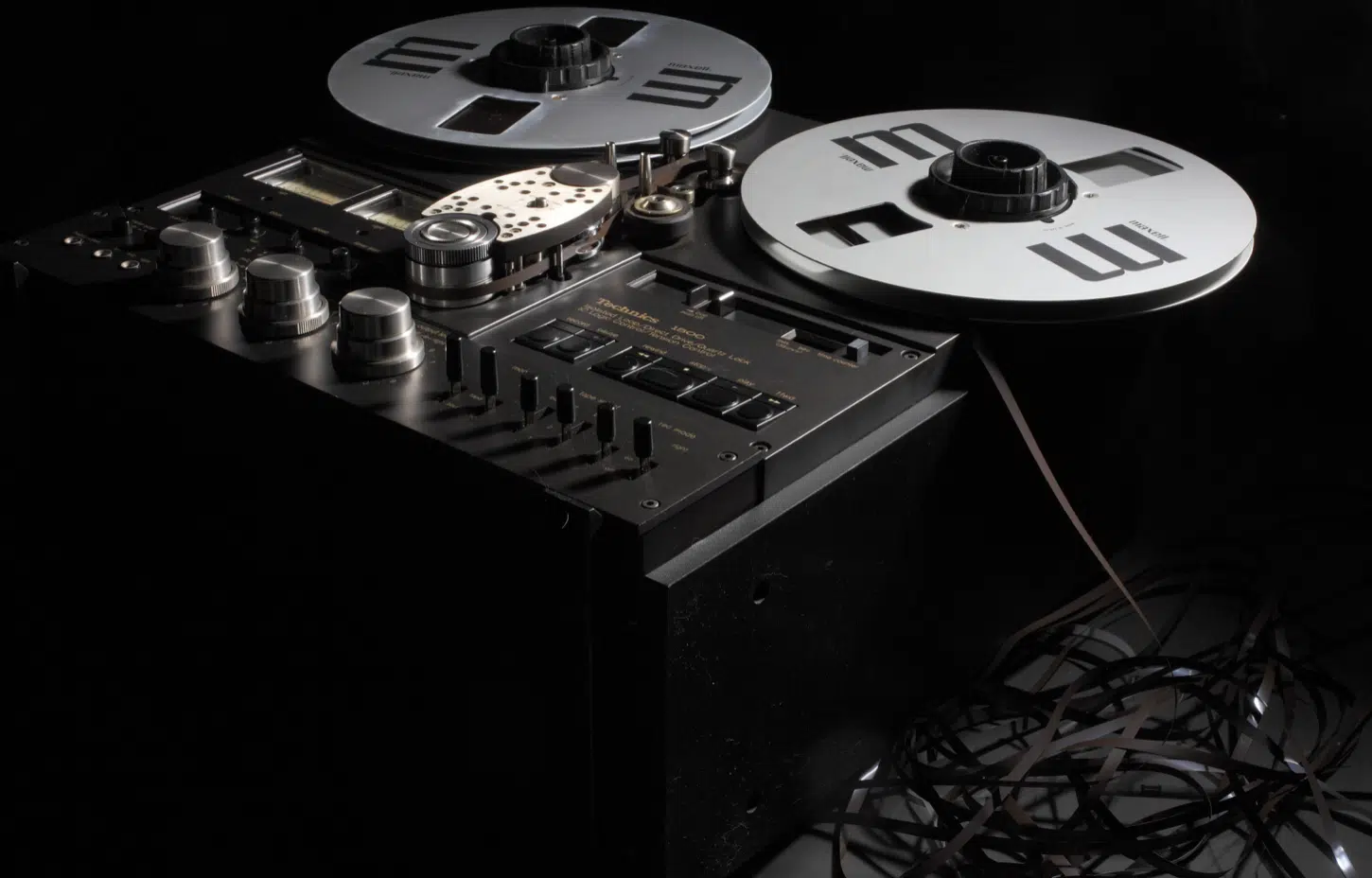
Tape delay adds a different flavor to the world of delay effects, offering a sound characterized by the character of magnetic tape.
Tape delays, which historically used actual tape loops and a tape record to create the effect, deliver a warmth and depth that digital and analog delays can only approximate.
The natural compression and saturation as the tape passes over the play head give the delayed signal a unique tonal quality.
The imperfections of tape delay (such as the slight warble from tape wow and flutter) add to its charm.
These imperfections are often what producers seek when they want a sound that feels:
- Alive
- Authentic
- Organic
- Exciting
Tape delay units like the famous Roland Space Echo have a revered place in music production history and continue to inspire contemporary music producers looking for that signature sound.
Tape delay is not just a relic of the past 一 many delay units, digital reverb units, and plugins have harnessed this essence.
It provides more overall control and reliability.
Whether used subtly for a hint of movement or cranked up for a full-on psychedelic experience, tape delay remains a beloved tool for adding space and dimension.
NOTE: It can be especially effective when used on vocals or sparse melodic elements, where the texture of the tape can be most appreciated.
Crafting Your Sound with Delay
Before diving deeper into the applications of delay in music production, it’s crucial to understand how this effect can be the difference between a flat track and a dynamic masterpiece.
So, let’s break it down.
-
Delay in Modern Music Production: How Can it Enhance My Tracks
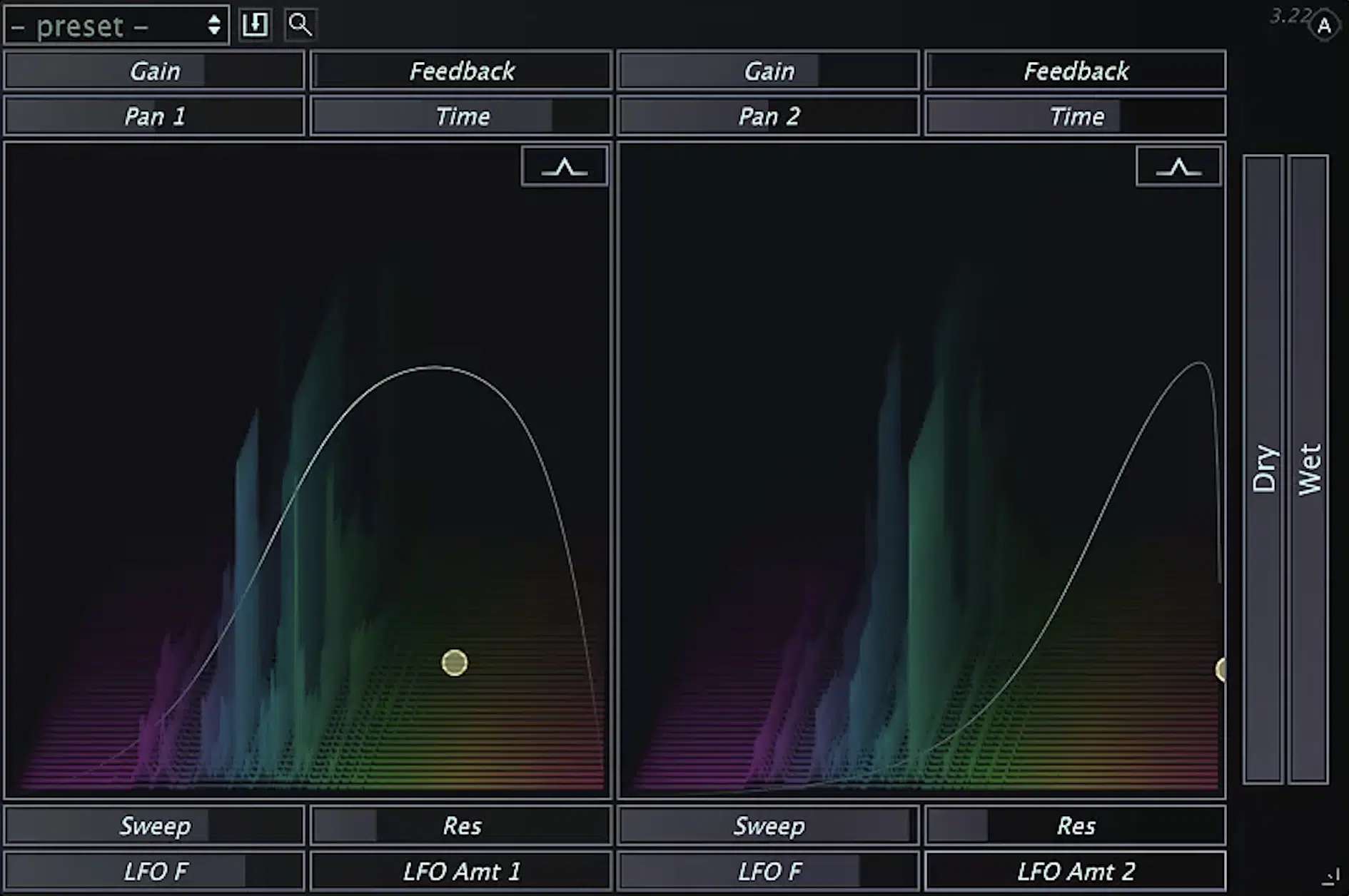
Delay in music is more than just an echo; it’s a creative tool that can transform a simple melody or beat into something complex.
By using delay effects, producers can add depth and space to their music, making each element of the mix stand out.
In music production, delay is often used to give digital instruments a sense of place.
This creates the illusion that they are occupying physical space.
For instance, a simple hi-hat pattern can gain a groove and swing with the right delay settings, turning a static rhythm into something that feels more organic.
In trap, where the rhythm is a central component, delay effects can add a signature bounce that defines the genre’s sound.
Delay can also be used to:
- Thicken vocals
- Create call-and-response patterns
So, when you ask yourself, “What is delay in music?” remember that it’s about finding the sweet spot where the delayed signal (or echo signal) complements the original without overwhelming it.
In the mix, delay helps to create a sense of movement and evolution within individual tracks 一 keeping the listener engaged.
Understanding how to use delay effectively means the ability to add dimension and interest to your productions.
-
Creative Delay Techniques Every Producer Must Master
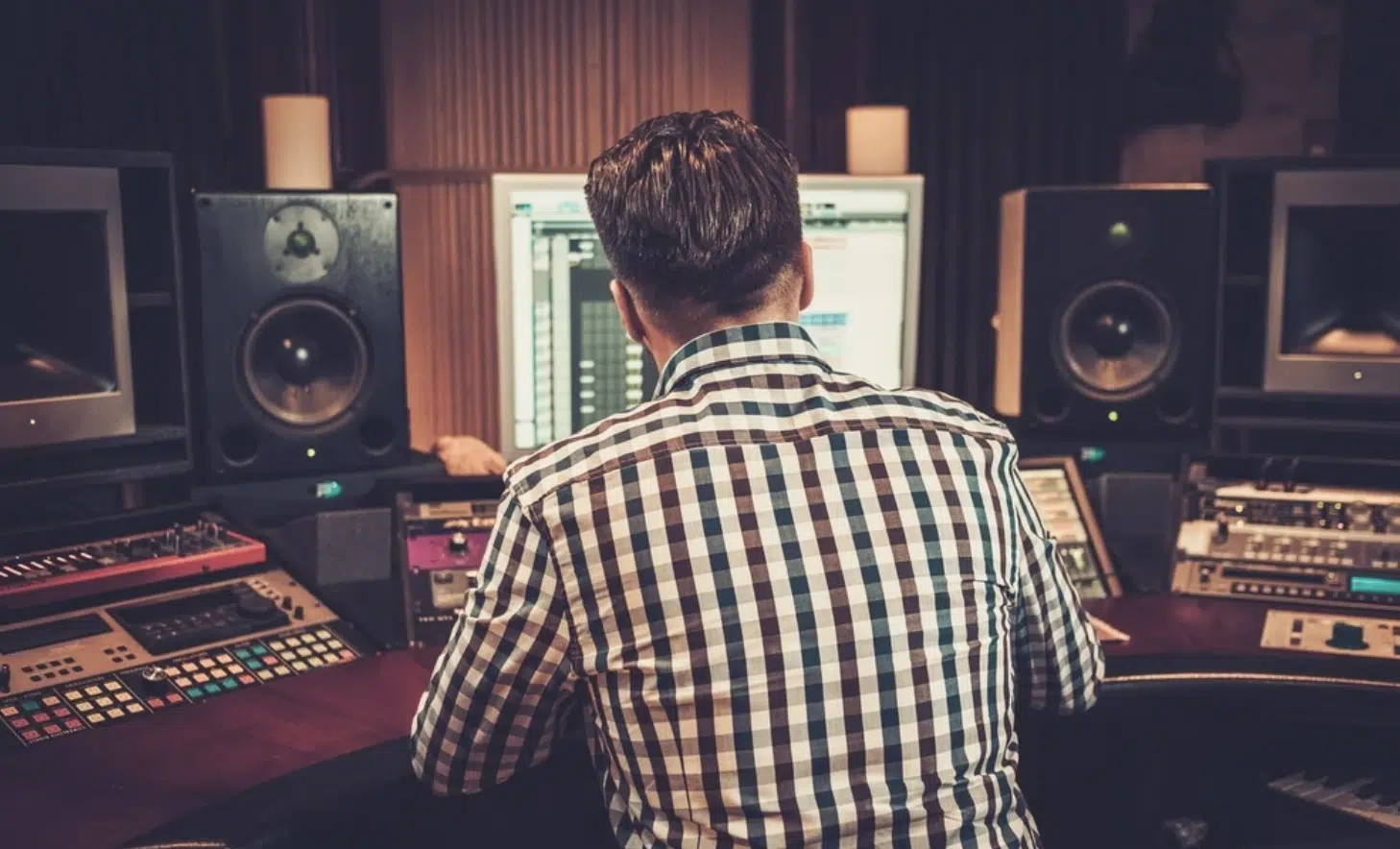
Creative use of delay can be a defining feature of a producer’s sound, and here are a few of the most intriguing options:
#1. Use Multiple Delays
Using multiple delays, where different delay times are used on the same sound source, creates a complex, polyrhythmic effect. This technique can add a unique rhythmic structure to a track. It transforms simple patterns into something much more intricate and appealing.
#2. Use Filtered Delays
Using filtered delays, where the delayed signal, not the incoming signal, is processed with a high-pass or low-pass filter, is super beneficial. When you use delay this way, it helps to separate the delayed sound from the original, creating a more nuanced and interesting sonic landscape. It’s a subtle way to add variety without cluttering the mix.
#3. Reversing the Signal
Reversing the delayed signal is another creative method that can lead to unexpected and inspiring results. A reverse delay can add a dreamy, ethereal quality to a sound 一 making it feel like it’s receding into the distance before it even begins.
#4. Bounce, Bounce, Bounce
Incorporating short, snappy delays on snare hits or rimshots can accentuate the rhythm and add an extra layer of bounce to your beat. It utilizes a straight delay effect with a tight delay time, creating a subtle repeat that vibes with the track’s tempo.
The Captivating World of Delay Effects
Now, let’s delve into the practical and creative ways delay effects can be woven into your music and make it shine like never before.
With the right approach, delay can flavor your tracks with an unmistakable identity.
-
Delay as a Rhythmic Tool
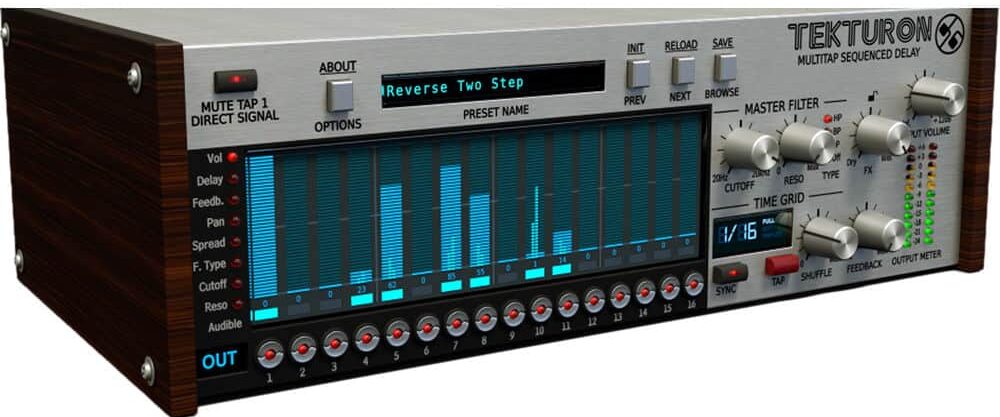
Using delay as a rhythmic tool is one of the most powerful techniques around.
By syncing the delay time to the track’s BPM (beats per minute), you create a cohesive musical echo that reinforces the song’s rhythm.
It’s not just about repeating a sound; it’s about extending the groove of your track across time.
For music producers, utilizing delay times that match the tempo creates a stutter or bounce effect, which is super desirable.
It can make a simple one-shot sample sound like a meticulously arranged pattern.
This can be particularly effective on percussive elements, where the delayed signal adds complexity to a beat.
Experimenting with off-beat delay times can also yield interesting results.
A delay set to repeat on the off-beats, or ‘ands’ of the measure, can add a sense of propulsion and swing.
NOTE: This is great for genres that thrive on syncopation, injecting a groove that can make a track stand out and ensuring the sound plays out correctly.
By tweaking delay parameters like feedback (or the feedback path), you can control how long the rhythmic delay continues before it fades away.
This is essential for ensuring that the delay enhances rather than overwhelms the rhythm you’ve crafted.
When you use delay effectively, it will create a balance that complements the natural dynamics of your track and never produces a dry sound again.
-
Atmospheric and Textural Uses of Delay
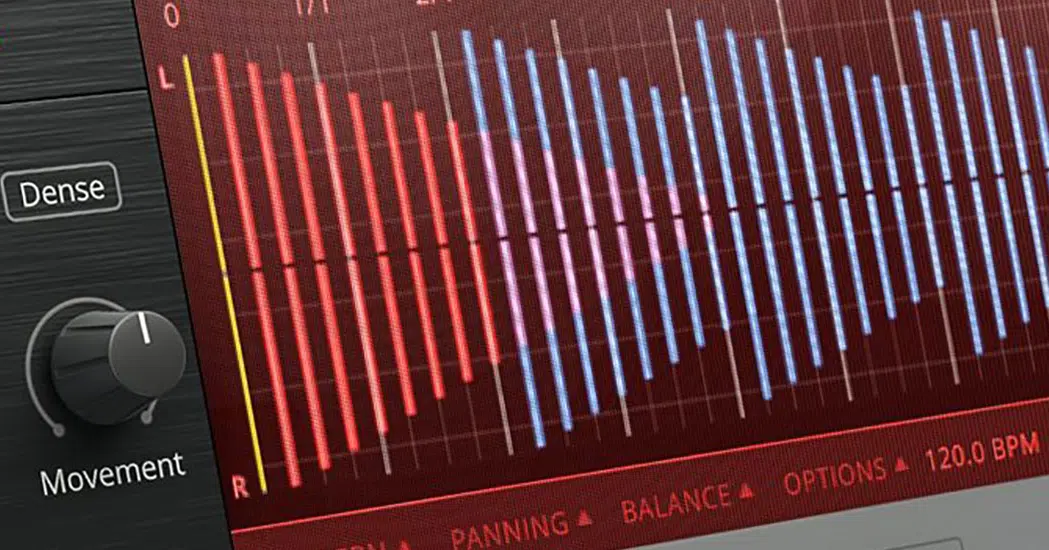
Beyond rhythm, you can use delay to create atmosphere and texture in a track.
Long delay times with a high feedback setting (which you can find in your delay unit or digital delay plugin) can turn a short sound into a lingering, ambient wash.
This is ideal for creating pads or atmospheric sounds that can fill out the background of a mix.
You can also use ping-pong delay to send echoes bouncing between the left and right channels, which is an effective way to add width and interest to a mix.
This type of stereo delay can make the sound field more immersive 一 allowing listeners to feel enveloped by the music.
Another atmospheric use of delay is to apply it to reverb tails (different than a delay tail), which can blur the line between the original signal and the delayed sound.
This creates a lush, expansive effect that can make even the simplest melody feel grand and cinematic.
Applying different types of delay to various elements of a track can also help to create a sense of depth.
Short delays might bring elements to the foreground, while longer delays with lower mixes can push elements to the back.
This will help you sculpt a three-dimensional mix.
-
The Art of Ping-Pong Delay
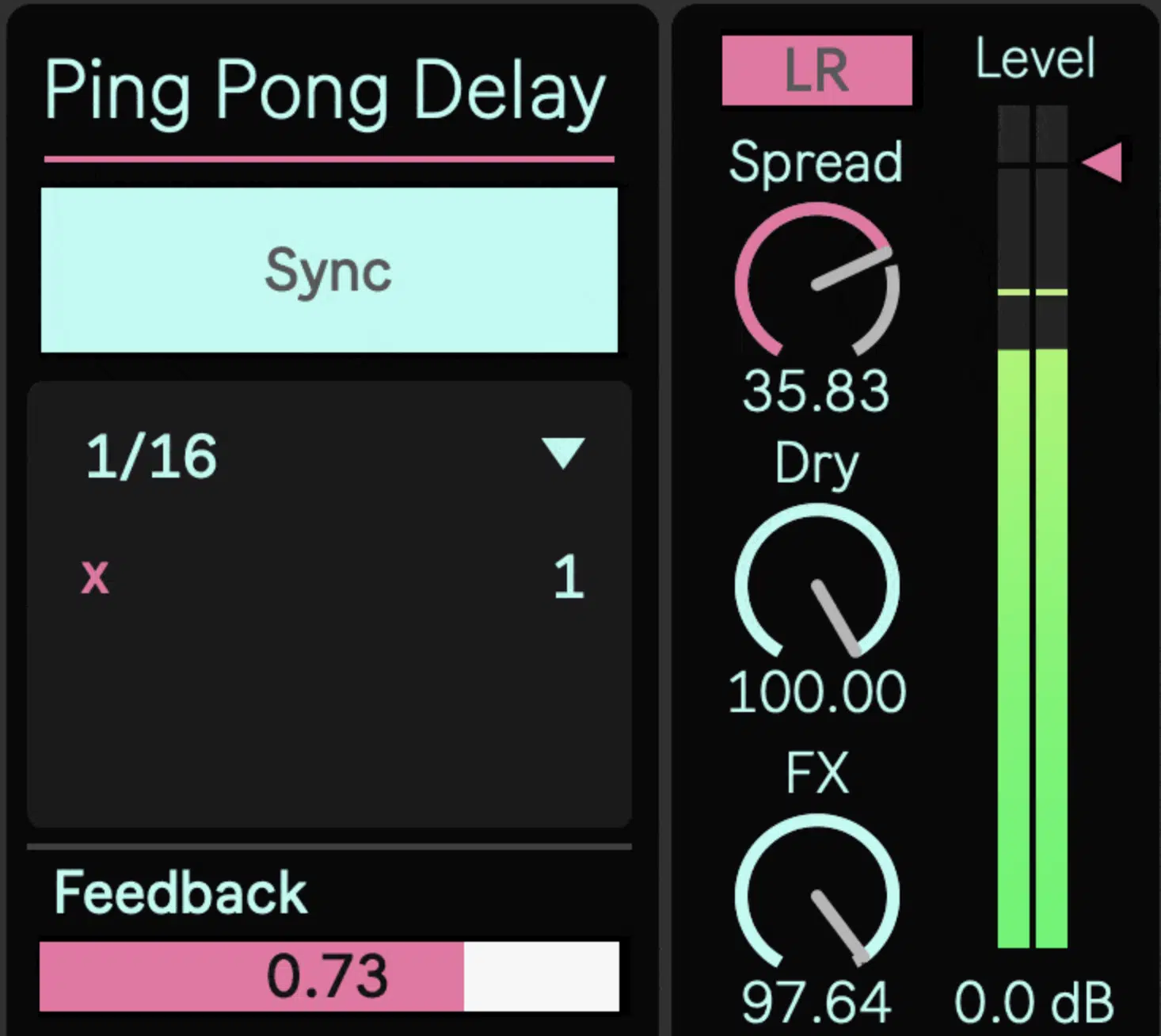
Ping-pong delay, a subtype of stereo delay, is a beloved effect in electronic music production for its engaging stereo movement.
It works by alternating the delayed signal between the left and right channels, creating a sense of movement that can energize your track.
Ping-pong delay can add an element of playfulness and complexity.
It’s especially captivating when used on melodic elements or ear-catching sound effects, as it draws the listener’s attention from one ear to the other.
Timing is critical with ping pong delay.
Setting the delay time so that the bounces rhythmically align with the tempo of the track can turn a static sound into one that dances around the stereo field.
It’s a dynamic way to use space creatively 一 giving your track a distinctive edge.
However, it’s essential not to overdo it; ping-pong delay should enhance the spatial quality of the mix without creating a disorienting effect.
Subtlety is key, allowing the effect to complement the original sound rather than dominate it and drown it out.
-
Creating Space with Stereo Delay
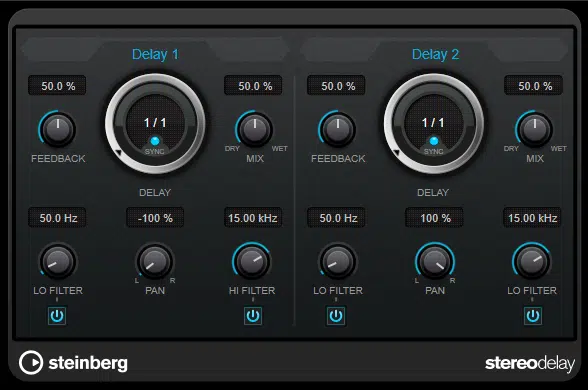
Stereo delay is an extension of the delay that can provide width and space to your mix.
By applying different delay times or feedback amounts to the left and right channels, you can create a sense of expansiveness that mono delays can’t achieve.
In digital music production, stereo delay can help synthesize the natural acoustic phenomena in physical spaces.
It mimics the complex interactions of sound reflections 一 giving electronic elements a place within an imagined room or hall.
Stereo delay is particularly useful when adding dimension to a centered sound.
It can make a lead vocal or solo instrument seem larger and more present without adding more elements to the mix.
It’s also essential to tailor the stereo delay settings to the content of the track.
For instance, a delicate acoustic guitar might benefit from a subtle, gentle stereo delay to enhance its natural resonance.
A sharp synth lead, on the other hand, might stand out with a more pronounced, rhythmic stereo delay that contributes to the track’s overall energy and movement.
So, to make stereo delay work for you, remember it’s all about context.
Technical Talk: Dive into Delay Parameters
To truly master delay effects, one must understand the intricacies of their parameters.
This technical knowledge will help you dial in your desired sounds precisely and intentionally.
-
Understanding Feedback Controls
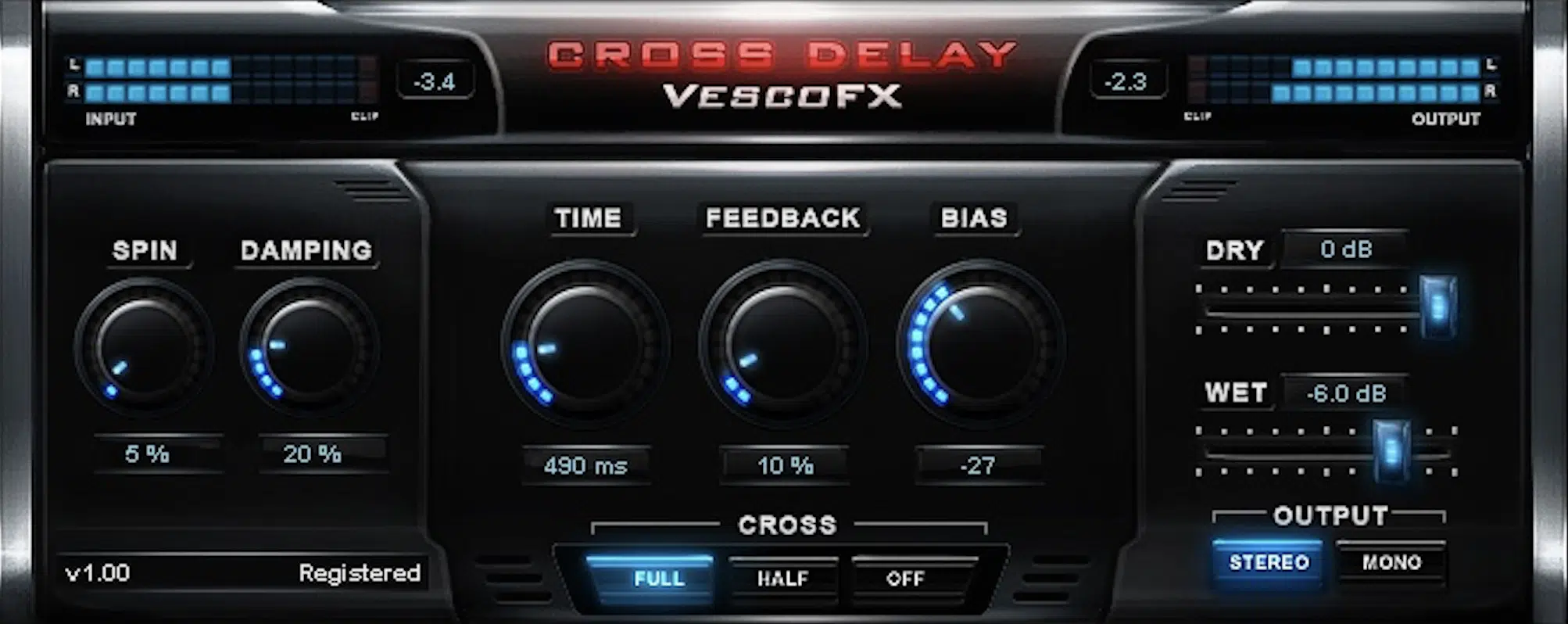
In delay terms, feedback refers to the amount of the processed signal that is sent back through the delay line.
High feedback settings result in more delay repetitions, while lower settings give fewer repeats.
Feedback control is essential for creating everything from subtle echoes to intense, cascading soundscapes.
The key to using feedback effectively is to balance it with the mix.
- Too much feedback 一 Causes a delay signal to spiral into chaos.
- Too little feedback 一 Might not give the desired sustain or atmospheric effect.
Feedback can also interact with the delay filter controls, if available, to shape the tonal quality of the repeats.
High-pass filters can reduce the low-frequency content of the feedback, preventing muddiness; low-pass filters can tame the brightness, allowing for warmer, more analog-sounding repeats.
Automating the feedback amount can lead to evolving delay textures.
This can be particularly effective in transitional music sections, such as build-ups or breakdowns.
This is where the increasing tension or release is mirrored in the growing or diminishing delay feedback.
-
Manipulating Delay Time for Effect
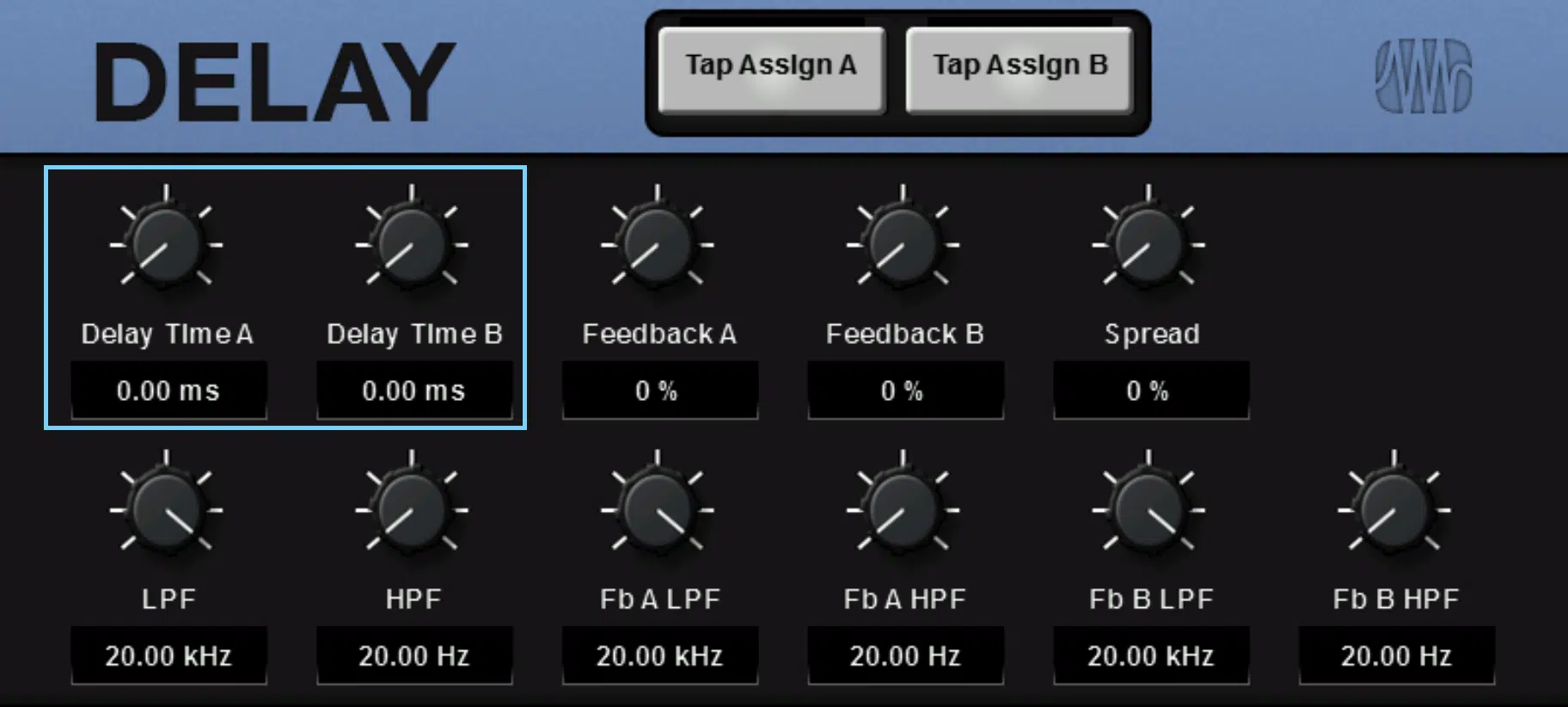
Delay time is the interval between the original signal and its echo and is typically measured in milliseconds (ms).
Short delay times can create effects such as slapback or flanging.
Longer delay times can produce distinct echoes or even rhythmic patterns if synchronized with the project tempo.
Modulating delay time can produce a Doppler-like effect 一 adding a sense of movement and interest.
In electronic music, this technique can be used to create risers or sweeps that build energy, leading into a drop or chorus.
The interplay between delay time and track tempo is a crucial consideration.
Delays synced to the beat (synced delay) can reinforce a song’s groove, whereas unsynced delays can be used for a more loose, natural feel.
Or to add an element of unpredictability to the rhythm.
In some advanced delay units, plugins, or other digital signal processing electronics, you can have multiple delay lines with different times.
This creates complex, polyrhythmic effects.
Producers can use these for advanced sound design, crafting textures that would be difficult to achieve with traditional instrumentation alone.
-
Enhance Your Mix: Balancing Your Wet Signals & Dry Signals
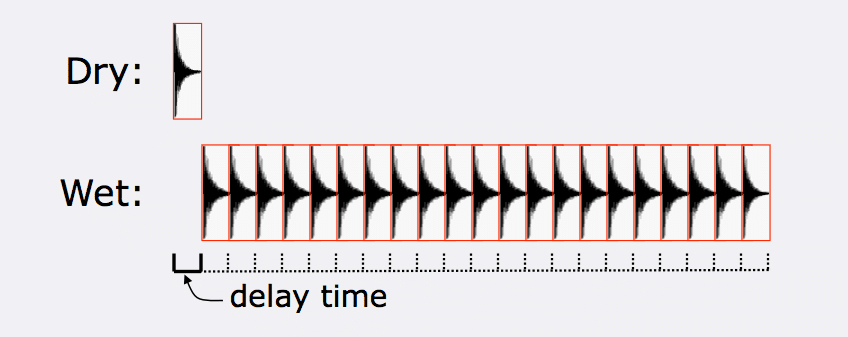
The wet/dry mix in a delay effect determines the balance between the unaffected ‘dry’ signal and the processed ‘wet’ echo.
To give you an example:
- A 100% wet signal 一 Would mean all you hear is the delay.
- A 100% dry signal 一 Would have no delay effect at all.
For subtle applications, a lower wet signal may be blended with the dry signal to add a slight sense of space without overtly signaling delay.
Conversely, in electronic and experimental music, a higher wet mix can transform a sound into something entirely new.
In this case, it would act as a feature effect rather than just an enhancement.
By pushing the wet signal, delays can dominate the soundscape.
This creates a hypnotic and captivating listening experience where the echoes become as important as the original sound or input signal.
The key to an effective wet/dry balance is context and purpose.
Automation can also play a role here, with the wet/dry mix changing over time to bring the delay to the forefront or to tuck it away subtly during different sections of a song.
Delay Plugins and Gear
With the fundamentals of delay parameters explored, let’s turn to the practical aspects of selecting and utilizing delay plugins and gear within a production setup.
This way, you can use delay like a true professional.
-
Choosing the Right Delay Plugin
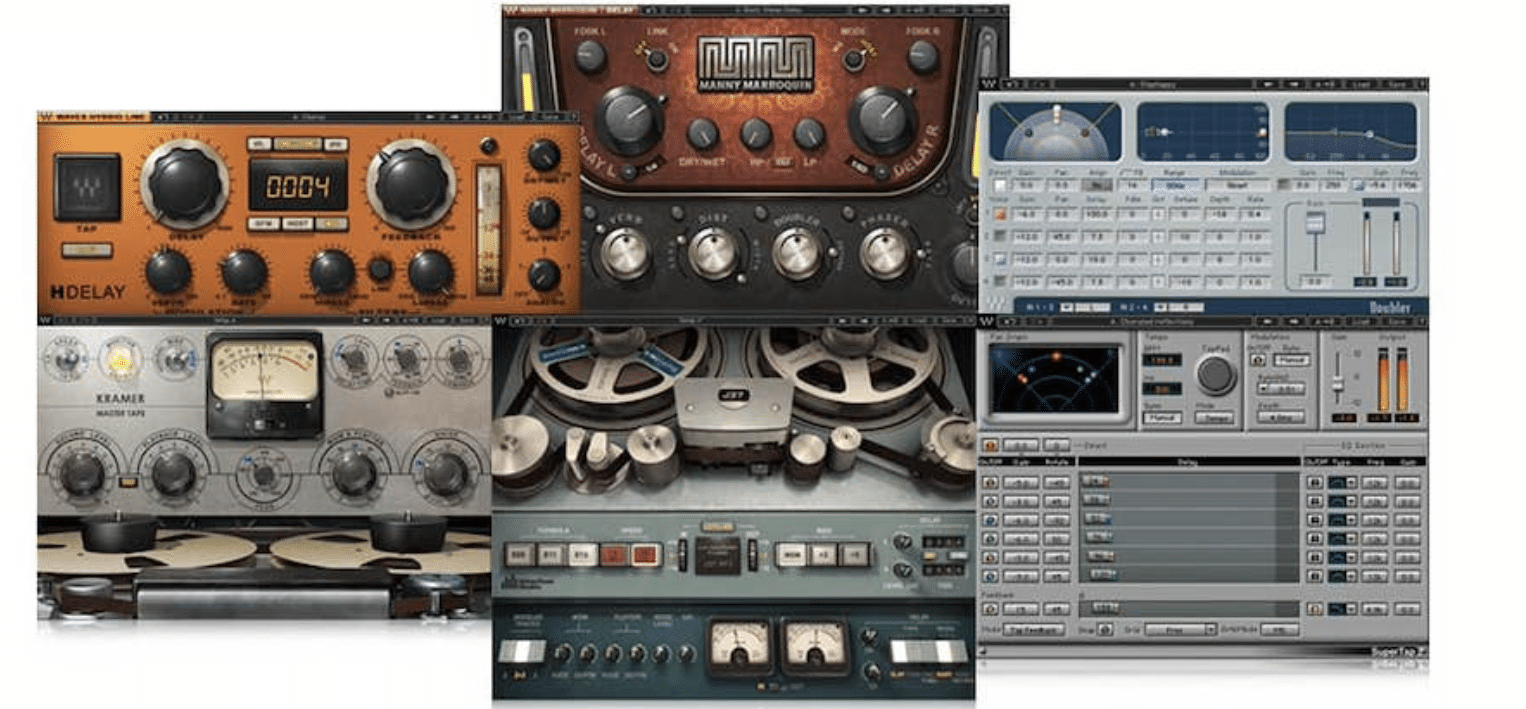
The market is saturated with delay plugins, each offering a unique set of features and tonal characteristics.
When choosing a delay plugin, it’s important to consider:
- The types of delays it can produce
- Its interface and the level of control it offers
- How well it fits into your workflow
Some delay plug ins are designed to emulate classic hardware delays, providing vintage tones and warmth that can be hard to replicate with more modern units.
Other delay plugins are designed with a more contemporary approach, like a digital delay pedal.
This offers pristine digital repeats and a vast array of programmable parameters for more complex sound design.
The user interface (UI) is also a critical factor.
Some producers prefer a simple, streamlined UI that allows for quick adjustments on the fly, while others may favor a more detailed interface that offers deeper tweaking capabilities.
Ultimately, the choice of a digital delay plug in should be based on the musical context, the desired sound, and how the tool inspires you.
Many producers collect a variety of delay plugins (and many delay units) have a broad palette of echo effects at their disposal.
If you go that route, you’ll always find the right type of delay for any given situation.
-
Integration of Delay in Your Signal Chain
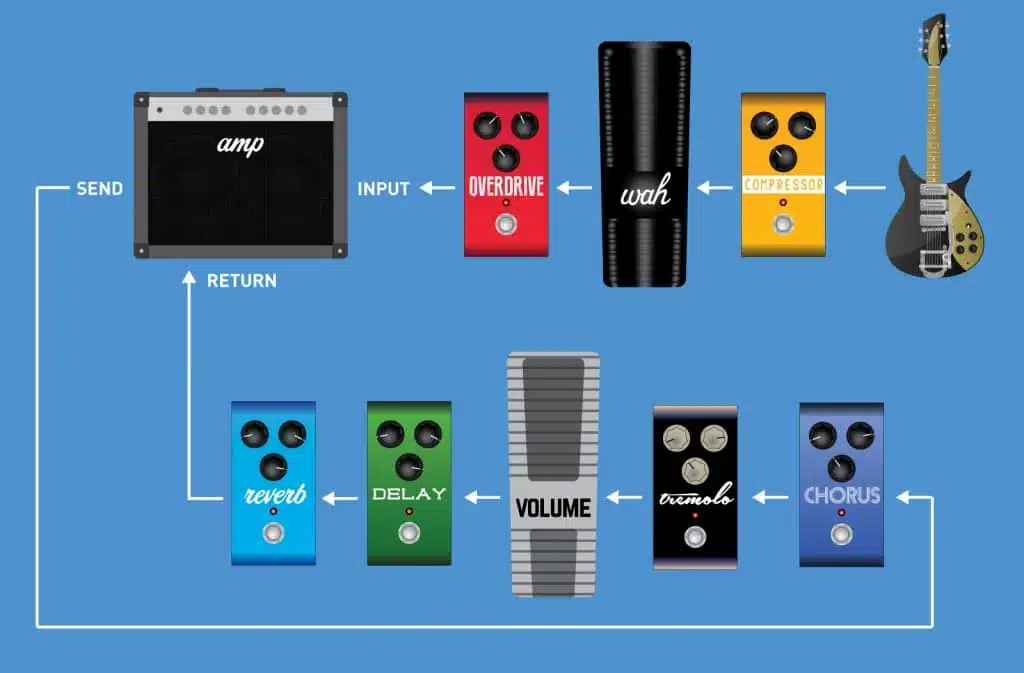
Integrating delay into your signal chain is a crucial step in using the effect to its fullest potential.
Whether using a hardware unit or a delay plugin, placement is key.
Delays can be inserted directly on a track or channel or placed on an auxiliary send for shared processing across multiple tracks (an audio signal processing technique).
Using a delay on an aux send is particularly advantageous when applying the same type of delay to several elements of a mix.
This creates a cohesive, ideal soundstage.
It also allows for more flexible mixing, as you can adjust the level of the delay send independently from the dry signal.
Careful consideration should also be given to the order of effects when delay is used in conjunction with other processors like:
For example, placing a delay before a reverb can create a sense of space, as the echoes themselves are reverberated, while a delay after a reverb can highlight the reverb tail.
Ultimately, delay’s creative possibilities are nearly limitless, and its integration into the signal chain can be as conventional or experimental as the music demands.
By understanding the effect’s parameters and the nuances of its application, you can use delay to craft sounds that elevate your music to new sonic territories.
What is Delay in Music? Final Thoughts
Delay, as you now know, is a complete game-changer, taking your tracks from boring to extraordinary.
Through the array of delay types and techniques, the ability to enhance rhythm, atmosphere, and space in your productions is profound and mind-blowing.
As you look to apply these concepts in your own tracks, these Free Project Files stand as an invaluable resource.
They provide a real-world window into professional tracks, showcasing how top producers and sound designers leverage delay to create hits in genres like hip-hop, pop, and EDM.
Exploring these project files can offer a practical perspective on applying delay in your productions.
Which emulate the theoretical knowledge we’ve unpacked today.
Whether it’s a subtle tape delay warmth or a bold digital delay punch, you’ll see how these elements are not just added but integrated meticulously.
Remember, understanding what is delay in music is about more than just theory 一 it’s about application.
It’s about turning a simple beat into an experience that resonates.
So, grab those free project files, get hands-on, and let delay be the tool that elevates your music from the studio to the top charts.
Until next time…







Leave a Reply
You must belogged in to post a comment.